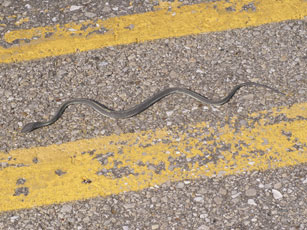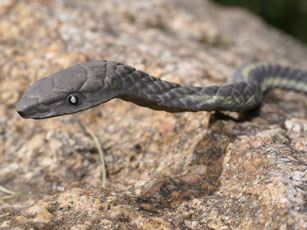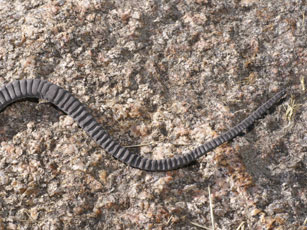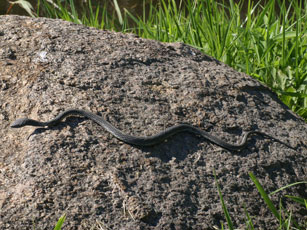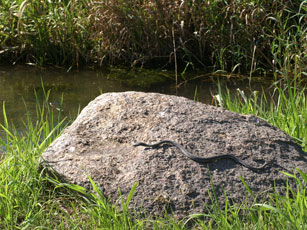
7-07-10
Trip Details
Start Time: 4:30 p.m.
Weather: Sunny, high of 85 degrees.
Location: Linn County Iowa
Herpers: Jim Scharosch
Account by: Jim Scharosch
Photos by: Jim Scharosch
Thought of the Day: WTF?!?!
We don't road cruise a lot looking for snakes in Iowa. It's not that you can't find stuff road cruising, but there aren't a lot of "hot spots" so generally your driving to snake ratio is so high that it often isn't worth the time. When you find a snake on the road in Iowa its generally a byproduct of being in the car because you are going from point A to point B. We don't have a "Whitewater" or "Pandale Dirt Road" in Iowa. We Iowa herpers may not develop the keen "roadcrusing eyes" that our brother herpers in the west or southeastern part of the country do, but I'm pretty good at making an ID of any snake I might pass on the road in my home state. I can normally ID a snake in pretty much any condition between alive and road leather, even when I'm driving seventy miles per hour on I-380 and the snake is on the opposite shoulder.
That's what made today's experience so strange. I was driving home "the back way" after stopping off to pick up a few things from a store on the far side of town. This route takes me away from my normal interstate highway travel and places me on paved roads that are at least a little bit more herp friendly. This route also takes me through an area of Linn County where there has been a reported sighting of a Black Rat Snake, though I don't believe it.
So as I was driving at or slightly above the posted speed limit of fifty-five miles per hour, I spotted a snake sitting right on the solid yellow lines of the highway. It wasn't in a coil, it was laying with perfect "S" curves. I was sure it had to have been hit, as it was fairly warm out and no snake would be laying right in the middle of the road with perfect "S" curves during the hottest part of the afternoon without moving off the road at a high rate of speed. In fact, it didn't move at all as I passed. Two things threw off my mental checklist that I run through as I attempt to ID a road snake. First, I was sure it had to have been hit, but the head was slightly elevated off the highway. Dead snakes, even ones that haven't been run over by every passing car for two hours, are almost always flat to the ground. Second, I didn't see any of the telltale signs that would normally allow me to figure out what kind of snake it was.
The thought popped into my head that even though I was sure there were no black rat snakes in the area, I had to turn around and at least see what kind of snake it was. So I stopped at the next safe spot and watched a car go by toward the snake. I thought it might be alive, so I watched the car until it passed the snake without swerving onto the yellow lines to hit it. I was relieved at that anyway. Even with the elevated head, I was still pretty sure it was dead, so I figured a thirty miles per hour drive by would allow me to ID the snake and be on my way.
Well, even at thirty miles per hour I had no idea what I was looking at.
I drove a little ways past the snake and turned around again, this time determined to stop and look at it out the door of my car. I checked my mirror and there were no cars behind me so I pulled right up along side the snake. Even when I was stopped right next to the snake I couldn't ID it. So I snapped a quick in-situ photograph.
At that point I decided to collect the snake and bring it home to study it more closely and take some more natural photos.
The patterning was indistinct, with a yellow stripe that travelled down the first third of the body then stopped. There was some yellow along the first and second scale row. As you can see in this head shot, the head is elongated and the pupil is round and white. The frontal and prefrontal scales are large.
The ventral scales have the same coloration as the rest of the snake.
The anal plate is single, as are the subcaudals
The snake posed nicely, never attempting to escape, though strangely it refused to coil up. When I attempted to get it to coil, it would just spring back to it's preferred "S" curve position. I was able to get a few nice pictures though. I was especially happy with the second shot, a "Snake in Habitat" kind of approach. I still do not have a positive ID of the snake and have no idea if it would normally be found near water. The habitat it was found near was pasture with a creek nearby, so maybe I'm not too far off.
Anyway, even though it goes against what we stand for here at herpjournal, I have decided to collect the snake and keep it in case it ends up being of any scientific value. If anyone can ID this snake, drop me an email.

